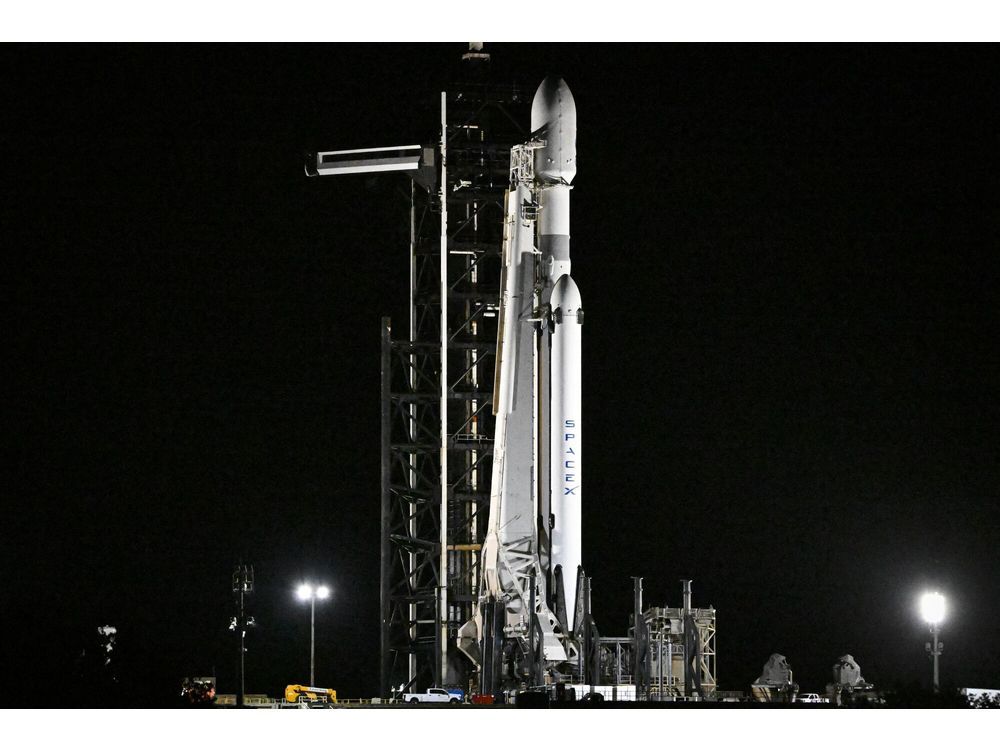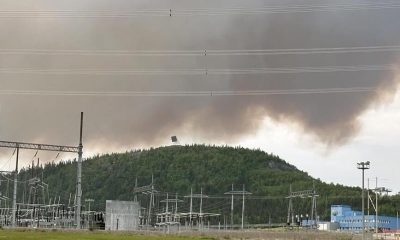Science
NASA's DAVINCI Space Probe To Plunge Through Hellish Atmosphere of Venus – SciTechDaily
NASA’s DAVINCI mission will study the origin, evolution, and present state of Venus in unprecedented detail from near the top of the clouds to the planet’s surface. The mission’s goal is to help answer longstanding questions about our neighboring planet, especially whether Venus was ever wet and habitable like Earth. Credit: NASA’s Goddard Space Flight Center
Last year, NASA selected the DAVINCI mission as part of its Discovery program. It will investigate the origin, evolution, and present state of <span class="glossaryLink" aria-describedby="tt" data-cmtooltip="
” data-gt-translate-attributes=”["attribute":"data-cmtooltip", "format":"html"]”>Venus in unparalleled detail from near the top of the clouds to the planet’s surface. Venus, the hottest planet in the solar system, has a thick, toxic atmosphere filled with carbon dioxide and an incredible pressure of pressure is 1,350 psi (93 bar) at the surface.
Named after visionary Renaissance artist and scientist Leonardo da Vinci, the DAVINCI mission Deep Atmosphere Venus Investigation of Noble gases, Chemistry, and Imaging will be the first probe to enter the Venus atmosphere since <span class="glossaryLink" aria-describedby="tt" data-cmtooltip="
” data-gt-translate-attributes=”["attribute":"data-cmtooltip", "format":"html"]”>NASA’s Pioneer Venus in 1978 and USSR’s Vega in 1985. It is scheduled to launch in the late 2020s.
Now, in a recently published paper, NASA scientists and engineers give new details about the agency’s Deep Atmosphere Venus Investigation of Noble gases, Chemistry, and Imaging (DAVINCI) mission, which will descend through the layered Venus atmosphere to the surface of the planet in mid-2031. DAVINCI is the first mission to study Venus using both spacecraft flybys and a descent probe.
DAVINCI, a flying analytical chemistry laboratory, will measure critical aspects of Venus’ massive atmosphere-climate system for the first time, many of which have been measurement goals for Venus since the early 1980s. It will also provide the first descent imaging of the mountainous highlands of Venus while mapping their rock composition and surface relief at scales not possible from orbit. The mission supports measurements of undiscovered gases present in small amounts and the deepest atmosphere, including the key ratio of hydrogen isotopes – components of water that help reveal the history of water, either as liquid water oceans or steam within the early atmosphere.
[embedded content]
NASA has selected the DAVINCI+ (Deep Atmosphere Venus Investigation of Noble-gases, Chemistry and Imaging +) mission as part of its Discovery program, and it will be the first probe to enter the Venus atmosphere since NASA’s Pioneer Venus in 1978 and USSR’s Vega in 1985. Named for visionary Renaissance artist and scientist, Leonardo da Vinci, the DAVINCI+ mission will bring 21st-century technologies to the world next door. DAVINCI+ may reveal whether Earth’s sister planet looked more like Earth’s twin planet in a distant, possibly hospitable past with oceans and continents. Credit: NASA’s Goddard Space Flight Center
The mission’s carrier, relay, and imaging spacecraft (CRIS) has two onboard instruments that will study the planet’s clouds and map its highland areas during flybys of Venus and will also drop a small descent probe with five instruments that will provide a medley of new measurements at very high precision during its descent to the hellish Venus surface.
“This ensemble of chemistry, environmental, and descent imaging data will paint a picture of the layered Venus atmosphere and how it interacts with the surface in the mountains of Alpha Regio, which is twice the size of Texas,” said Jim Garvin, lead author of the paper in the Planetary Science Journal and DAVINCI principal investigator from NASA’s Goddard Space Flight Center in Greenbelt, Maryland. “These measurements will allow us to evaluate historical aspects of the atmosphere as well as detect special rock types at the surface such as granites while also looking for tell-tale landscape features that could tell us about erosion or other formational processes.”

DAVINCI will send a meter-diameter probe to brave the high temperatures and pressures near Venus’ surface to explore the atmosphere from above the clouds to near the surface of a terrain that may have been a past continent. During its final kilometers of free-fall descent (artist’s impression shown here), the probe will capture spectacular images and chemistry measurements of the deepest atmosphere on Venus for the first time. Credit: NASA/GSFC/CI Labs
DAVINCI will make use of three Venus gravity assists, which save fuel by using the planet’s gravity to change the speed and/or direction of the CRIS flight system. The first two gravity assists will set CRIS up for a Venus flyby to perform remote sensing in the ultraviolet and the near infrared light, acquiring over 60 gigabits of new data about the atmosphere and surface. The third Venus gravity assist will set up the spacecraft to release the probe for entry, descent, science, and touchdown, plus follow-on transmission to Earth.
The first flyby of Venus will be six and half months after launch and it will take two years to get the probe into position for entry into the atmosphere over Alpha Regio under ideal lighting at “high noon,” with the goal of measuring the landscapes of Venus at scales ranging from 328 feet (100 meters) down to finer than one meter. Such scales enable lander-style geologic studies in the mountains of Venus without requiring landing.

The DAVINCI deep atmosphere probe descends through the dense carbon dioxide atmosphere of Venus towards the Alpha Regio mountains. Credit: NASA’s Goddard Space Flight Center
Once the CRIS system is about two days away from Venus, the probe flight system will be released along with the titanium three foot (one meter) diameter probe safely encased inside. The probe will begin to interact with the Venus upper atmosphere at about 75 miles (120 kilometers) above the surface. The science probe will commence science observations after jettisoning its heat shield around 42 miles (67 kilometers) above the surface. With the heatshield jettisoned, the probe’s inlets will ingest atmospheric gas samples for detailed chemistry measurements of the sort that have been made on <span class="glossaryLink" aria-describedby="tt" data-cmtooltip="
” data-gt-translate-attributes=”["attribute":"data-cmtooltip", "format":"html"]”>Mars with the Curiosity rover. During its hour-long descent to the surface, the probe will also acquire hundreds of images as soon as it emerges under the clouds at around 100,000 feet (30,500 meters) above the local surface.
“The probe will touch-down in the Alpha Regio mountains but is not required to operate once it lands, as all of the required science data will be taken before reaching the surface.” said Stephanie Getty, deputy principal investigator from Goddard. “If we survive the touchdown at about 25 miles per hour (12 meters/second), we could have up to 17-18 minutes of operations on the surface under ideal conditions.”
DAVINCI is tentatively scheduled to launch June 2029 and enter the Venusian atmosphere in June 2031.
“No previous mission within the Venus atmosphere has measured the chemistry or environments at the detail that DAVINCI’s probe can do,” said Garvin. “Furthermore, no previous Venus mission has descended over the tesserae highlands of Venus, and none have conducted descent imaging of the Venus surface. DAVINCI will build on what Huygens probe did at Titan and improve on what previous in situ Venus missions have done, but with 21st century capabilities and sensors.”
Reference: “Revealing the Mysteries of Venus: The DAVINCI Mission” by James B. Garvin, Stephanie A. Getty, Giada N. Arney, Natasha M. Johnson, Erika Kohler, Kenneth O. Schwer, Michael Sekerak, Arlin Bartels, Richard S. Saylor, Vincent E. Elliott, 24 May 2022, The Planetary Science Journal.
DOI: 10.3847/PSJ/ac63c2
NASA Goddard is the principal investigator institution for DAVINCI and will perform project management for the mission, provide science instruments as well as project systems engineering to develop the probe flight system. Goddard also leads the project science support team with an external science team from across the US. Discovery Program class missions like DAVINCI complement NASA’s larger “flagship” planetary science explorations, with the goal of achieving outstanding results by launching more smaller missions using fewer resources and shorter development times. They are managed for NASA’s Planetary Science Division by the Planetary Missions Program Office at Marshall Space Flight Center in Huntsville, Alabama.
Major partners for DAVINCI are Lockheed Martin, Denver, Colorado, The Johns Hopkins University Applied Physics Laboratory in Laurel, Maryland, NASA’s Jet Propulsion Laboratory, Pasadena, California, Malin Space Science Systems, San Diego, California, NASA’s Langley Research Center, Hampton, Virginia, NASA’s Ames Research Center at Moffett Federal Airfield in California’s Silicon Valley, and KinetX, Inc., Tempe, Arizona, as well as the University of Michigan in Ann Arbor.
Science
What happened to China’s Chang’e 6 lander on the moon’s far side?

China’s Chang’e 6 mission has successfully delivered to Earth the first-ever samples from the far side of the moon. But what became of the lander that collected the lunar material?
Chang’e 6 launched on May 3. The mission consisted of four spacecraft — an orbiter, lander, ascent vehicle and reentry capsule. The lander touched down in Apollo crater on June 1, with the main task of scooping and drilling for unique samples from the lunar far side and loading them into the ascender to be blasted into lunar orbit.
The samples eventually reached Earth on June 25, touching down as planned in grasslands in Inner Mongolia.
The Chang’e 6 lander, meanwhile, remains on the moon. It carried other payloads, including a panoramic imager and a tiny rover. Insights about the lander’s fate came recently from the French space agency CNES, which contributed a radon-outgassing-detection payload called DORN to the mission.
Related: China’s Chang’e 6 spacecraft finds long-sought particles on far side of the moon
“As planned, DORN was switched off shortly before Chang’e 6 lifted off from the lunar surface, when the ground platform became inactive,” a CNES press attache stated in an email.
The blastoff of the ascender likely caused extensive damage to the lander, though the latter managed to capture footage of the event. Accordingly, all activities — including the autonomous deployment of the rover and imaging of the lander — were wrapped up before liftoff. This included another European instrument that recorded previously undetected charged particles on the moon’s surface.
If any activities were conducted after the ascender’s liftoff, these would have ceased by nightfall over Apollo crater. Unlike the still-operational Chang’e 3 and Chang’e 4 landers on the lunar near and far sides, respectively, Chang’e 6’s lander did not carry the radioisotope heaters needed for long-term activities on the moon, which requires surviving the deep cold of the long lunar night. Nighttime in Apollo crater began on June 11, and the sun rose again over the site on June 26.
Meanwhile, the ascender, which carried the samples from the moon to the waiting Chang’e 6 spacecraft in lunar orbit, is now also out of action. Though China’s space authorities have not commented on the fate of the ascender, the rocket was likely responsibly deorbited into the moon after it docked with the orbiter and transferred the samples.
Radio amateur Scott Tilley tracked signals from the ascender, with their absence suggesting it had been instructed to impact the moon.
Quick update on Chang’e 6 mission. The Ascender was a no show today, indicative it has been deorbited and impacted on the Moon as CE5’s did following expected mission timeline. The Orbiter is behaving normally and has been in and out of lock with Argentina throughout today.June 8, 2024
RELATED STORIES:
China appears to have enacted the sample protocol with its Chang’e 5 mission, which returned samples from the moon’s near side to Earth in late 2020.
With all other aspects wrapped up, the reentry capsule and the samples within it were transported to Beijing on Wednesday (June 26). The samples will soon be transferred to specially developed facilities for storage, analysis and distribution for research.
Meanwhile, the Queqiao 2 lunar relay satellite, which helped facilitate the far side sample mission, will continue orbiting with its science payloads. It will support the ongoing Chang’e 4 mission and the upcoming Chang’e 7 mission, which will target the lunar south pole around 2026.

Science
SpaceX Falcon Heavy Launches Satellite to Track Sun Storms

(Bloomberg) — SpaceX’s Falcon Heavy, one of the world’s most powerful operational rockets, blasted off on Tuesday carrying into orbit a new US satellite designed to help weather forecasters monitor massive solar storms.
The rocket, comprised of three modified Falcon cores, launched from Florida’s Kennedy Space Center at 5:26 p.m. local time, according to a live webcast.
Article content
The satellite, known as GOES-U, was successfully deployed around 10 p.m. New York time, SpaceX said. Orbiting Earth at about 35,700 kilometers (22,200 miles), the satellite will use a compact coronagraph that will help weather forecasters monitor solar storms, track hurricanes and lightning, take atmospheric measurements and capture images of Earth.
GOES-U is the fourth and final satellite in a series from NOAA, the National Oceanic and Atmospheric Administration, and NASA. Once in orbit, it will be renamed GOES-19. GOES-16, the first in the series, launched in 2016.
A coronagraph is a telescope designed to block out the light of the sun so that researchers can see its corona or outermost layer. Coronagraphs help researchers predict the impact of solar flares and so-called coronal mass ejections — essentially massive expulsions of plasma and magnetic field lines — by measuring their size, velocity and density.
A solar storm can shine dazzling displays of light, such as the aurora in May. But the largest geomagnetic storm since 2003 also caused widespread radio blackouts and distortions to normal energy patterns across the Americas.
Last year, Falcon Heavy launched the world’s largest commercial communications satellite and, separately, the X-37B secretive spaceplane from the US Space Force.
SpaceX is separately developing an even bigger rocket, Starship, to launch satellites and take astronauts to the moon in the coming years.
(Updates with details on satellite deployment in third paragraph.)
Share this article in your social network

Science
Xi extends congratulations on complete success of Chang’e-6 mission

BEIJING, June 25 (Xinhua) — Chinese President Xi Jinping on Tuesday extended congratulations on the complete success of the Chang’e-6 mission, which brought back the world’s first samples collected from the moon’s far side.
On behalf of the Communist Party of China (CPC) Central Committee, the State Council and the Central Military Commission (CMC), Xi, also general secretary of the CPC Central Committee and chairman of the CMC, extended warm congratulations and sincere greetings to the Chang’e-6 mission headquarters and all those who participated in the mission in a congratulatory message.
The return capsule of the Chang’e-6 probe, carrying the moon samples, landed precisely in its designated area in Siziwang Banner, north China’s Inner Mongolia Autonomous Region, at 2:07 p.m. (Beijing Time) on Tuesday.
Xi noted that Chang’e-6, for the first time in human history, collected samples from the moon’s far side and returned to Earth, marking another landmark achievement in China’s endeavor to build a strong country in space as well as in science and technology.
Over the past 20 years, all those involved in the lunar exploration project have scaled the heights of science and technology, and made remarkable accomplishments that have captured worldwide attention, Xi said.
“The outstanding contributions you have made will always be remembered by the country and the people,” he said.
Xi called for meticulous research on the lunar samples, the continued implementation of the country’s major space projects, including deep space exploration, and enhancement of international exchanges and cooperation.
He also urged efforts to make new contributions to revealing the mysteries of the universe, to promoting the well-being of humanity, and to building a great country and advancing national rejuvenation on all fronts through Chinese modernization.
Vice Premier Ding Xuexiang, also a member of the Standing Committee of the Political Bureau of the CPC Central Committee, observed the landing and recovery of the Chang’e-6 returner at the Beijing Aerospace Control Center.
Vice Premier Zhang Guoqing, also a member of the Political Bureau of the CPC Central Committee, read out Xi’s congratulatory message at the center.
Launched on May 3, the Chang’e-6 mission went through 11 flight stages in 53 days. It made key-technology breakthroughs in such areas as lunar retrograde orbit design and flight control, intelligent and rapid sampling, and takeoff and ascent from the far side of the moon.
Carrying four international payloads, the Chang’e-6 probe also facilitated practical and efficient international cooperation.
Chinese Vice Premier Ding Xuexiang, also a member of the Standing Committee of the Political Bureau of the Communist Party of China Central Committee, observes the landing and recovery of the Chang’e-6 returner at the Beijing Aerospace Control Center in Beijing, capital of China, June 25, 2024. The return capsule of the Chang’e-6 probe, carrying the moon samples, landed precisely in its designated area in Siziwang Banner, north China’s Inner Mongolia Autonomous Region on Tuesday. (Xinhua/Zhai Jianlan)

Chinese Vice Premier Zhang Guoqing, also a member of the Political Bureau of the Communist Party of China (CPC) Central Committee, reads out a congratulatory message of Chinese President Xi Jinping, also general secretary of the CPC Central Committee and chairman of the Central Military Commission (CMC), at the Beijing Aerospace Control Center in Beijing, capital of China, June 25, 2024. On behalf of the CPC Central Committee, the State Council and the CMC, Xi extended warm congratulations and sincere greetings to the Chang’e-6 mission headquarters and all those who participated in the mission in the congratulatory message.
The return capsule of the Chang’e-6 probe, carrying the moon samples, landed precisely in its designated area in Siziwang Banner, north China’s Inner Mongolia Autonomous Region on Tuesday. (Xinhua/Zhai Jianlan)

-

 Science8 hours ago
Science8 hours agoWhat happened to China’s Chang’e 6 lander on the moon’s far side?
-

 News6 hours ago
News6 hours agoFederal government ends northern cod moratorium in Newfoundland after 32 years
-
Real eState8 hours ago
Big US banks withstand Fed’s commercial real estate shock scenario
-

 News8 hours ago
News8 hours agoPower back on in western Labrador after wildfires knocked out transmission lines
-
Sports7 hours ago
Edmonton Oilers stars McDavid, Draisaitl played through injuries in playoffs: coach
-

 Health5 hours ago
Health5 hours agoLittle sign of new tick-borne disease on Prince Edward Island — so far
-

 Tech19 hours ago
Tech19 hours agoOnePlus Nord CE4 Lite 5G With 2-Day Battery Launches With Sweet Preorder Perks
-
Business7 hours ago
Shell going ahead with Canadian carbon capture and storage projects





